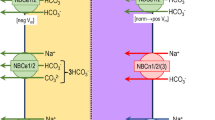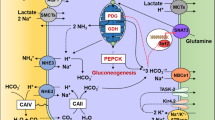Abstract
Heparan sulphate 2-O-sulphotransferase (Hs2st) acts at an intermediate stage in the pathway of biosynthesis of heparan sulphate (HS), catalysing the transfer of sulphate from 3′-phosphoadenosine-5′-phosphosulfate (PAPS) to the C2-position of selected hexuronic acid residues within the maturing HS chain. It is well established that 2-O-sulphation within HS, particularly of iduronate residues, is essential for HS to participate in a variety of high-affinity ligand-binding interactions. HS plays a central role in embryonic development and cellular function, modulating the activities of an extensive range of growth factors. Interestingly, in contrast to the early failure of embryos entirely lacking HS, Hs2st −/− mice survive until birth, but die perinatally due to a complete failure of kidney formation. The phenotype of Hs2st −/− mutant kidneys suggests that signalling between two tissues, ureteric bud and metanephric mesenchyme, is disrupted. We discuss candidate signalling molecules that may mediate this interaction. The HS generated by these mice lacks 2-O-sulphate groups but is extensively modified above wild type levels by O-sulphation at C-6 of glucosamine-N-sulfate (GlcNS) residues. We will discuss the potentially altered role of this atypical HS in growth factor signalling. Published in 2003.
Similar content being viewed by others
References
Selleck SB, Proteoglycans and pattern formation: Sugar biochemistry meets developmental genetics, Trends Genet 16, 206–12 (2000).
Perrimon N, Bernfield M, Specificities of heparan sulphate proteoglycans in developmental processes, Nature 404, 725–8 (2000).
Lyon M, Gallagher JT, Bio-specific sequences and domains in heparan sulphate and the regulation of cell growth and adhesion, Matrix Biol 17, 485–93 (1998).
Giraldez AJ, Copley RR, Cohen SM, HSPG Modification by the Secreted Enzyme Notum Shapes theWingless Morphogen Gradient, Dev Cell 2, 667–76 (2002).
Guimond SE, Turnbull JE, Fibroblast growth factor receptor signalling is dictated by specific heparan sulphate saccharides, Curr Biol 9, 1343–6 (1999).
Pye DA, Vives RR, Hyde P, Gallagher JT, Regulation of FGF-1 mitogenic activity by heparan sulfate oligosaccharides is dependent on specific structural features: Differential requirements for the modulation of FGF-1 and FGF-2, Glycobiology 10, 1183–92 (2000).
Lyon M, Deakin JA, Mizuno K, Nakamura T, Gallagher JT, Interaction of hepatocyte growth factor with heparan sulfate. Elucidation of the major heparan sulfate structural determinants, J Biol Chem 269, 11216–23 (1994).
Esko J, Lindahl, U, Molecular diversity of heparan sulfate, J Clin Invest 108, 169–73 (2001).
Lindahl U, Kusche-Gullberg M, Kjellén L, Regulated diversity of heparan sulfate, J Biol Chem 273, 24979–82 (1998).
Conrad HE, Heparin-Binding Proteins (Academic Press San Diego, 1998).
Maccarana M, Sakura Y, Tawada A, Yoshida K, Lindahl U, Domain structure of heparan sulfates from bovine organs, J Biol Chem 271, 17804–10 (1996).
Merry CL, Lyon M, Deakin JA, Hopwood JJ, Gallagher JT, Highly sensitive sequencing of the sulfated domains of heparan sulfate, J Biol Chem 274, 18455–62 (1999).
Safaiyan F, Lindahl U, Salmivirta M, Structural diversity of N-sulfated heparan sulfate domains: Distinct modes of glucuronyl C5 epimerization, iduronic acid 2-O-sulfation, and glucosamine 6-O-sulfation, Biochemistry 39, 10823–30 (2000).
Gallagher JT, Heparan sulfate: Growth control with a restricted sequence menu, J Clin Invest 108, 357–61 (2001).
Maccarana M, Casu B, Lindahl U, Minimal sequence in heparin/ heparan sulfate required for binding of basic fibroblast growth factor, J Biol Chem 268, 23898–905 (1993).
Bullock SL, Fletcher JM, Beddington RS, Wilson VA, Renal agenesis in mice homozygous for a gene trap mutation in the gene encoding heparan sulfate 2-sulfotransferase, Genes Dev 12, 1894–906 (1998).
Stanford WL, Cohn JB, Cordes SP, Gene-trap mutagenesis: Past, present and beyond, Nat Rev Genet 2, 756–68 (2001).
Wilson VA, Manson L, Skarnes WC, Beddington RS, The T gene is necessary for normal mesodermal morphogenic cell movements during gastrulation, Development 121, 877–86 (1995).
Friedrich G, Soriano P, Promoter traps in embryonic stem cells: A genetic screen to identify and mutate developmental genes in mice, Genes and Development 5, 1513–23 (1991).
Skarnes WC, Moss JE, Hurtley SM, Beddington RS, Capturing genes encoding membrane and secreted proteins important for mouse development, Proc Natl Acad Sci USA 92, 6592–6 (1995).
Lander ES, et al., Initial sequencing and analysis of the human genome, Nature 409, 860–921 (2001).
Venter JC, et al., The sequence of the human genome, Science 291, 1304–51 (2001).
Kobayashi M, Habuchi H, Yoneda M, Habuchi O, Kimata K, Molecular cloning and expression of Chinese hamster ovary cell heparan-sulfate 2-sulfotransferase, J Biol Chem 272, 13980–5 (1997).
Shworak NW, Liu J, Petros LM, Zhang L, Kobayashi M, Copeland NG, Jenkins NA, Rosenberg RD, Multiple isoforms of heparan sulfate D-glucosaminyl 3-O-sulfotransferase. Isolation, characterization, and expression of human cdnas and identification of distinct genomic loci, J Biol Chem 274, 5170–84 (1999).
Habuchi H, Tanaka M, Habuchi O, Yoshida K, Suzuki H, Ban K, Kimata K, The occurrence of three isoforms of heparan sulfate 6-O-sulfotransferase having different specificities for hexuronic acid adjacent to the targeted N-sulfoglucosamine, J Biol Chem 275, 2859–68 (2000).
Aikawa J, Grobe K, Tsujimoto M, Esko JD, Multiple isozymes of heparan sulfate/heparin GlcNAc N-deacetylase/ N-sulfotransferase: Structure and activity of the fourth member, NDST4, J Biol Chem 276, 5876–82 (2001).
Lin X, Wei G, Shi Z, Dryer L, Esko JD, Wells DE, Matzuk MM, Disruption of gastrulation and heparan sulfate biosynthesis in EXT1-deficient mice, Dev Biol 224, 299–311 (2000).
Forsberg E, et al., Abnormal mast cells in mice deficient in a heparin-synthesizing enzyme, Nature 400, 773–6 (1999).
Shworak NW, Post M, Enjoi K, Christi P, Lech M, Beeler D, Rayburn H, Rosenberg RD, 3-OST1 deficient mice lack an obvious procoagulant phenotype, Glycobiology 10, Abstract 20 (2000).
Ringvall M, Ledin J, Holmborn K, van Kuppevelt T, Ellin F, Eriksson I, Olofsson AM, Kjellén L, Forsberg E, Defective heparan sulfate biosynthesis and neonatal lethality in mice lacking N-deacetylase/N-sulfotransferase-1, J Biol Chem 275, 25926–30 (2000).
Merry CL, Bullock SL, Swan DC, Backen AC, Lyon M, Beddington RS, Wilson VA, Gallagher JT, The molecular phenotype of heparan sulfate in the Hs2st-/-mutant mouse, J Biol Chem 276, 35429–34 (2001).
Bai X, Esko JD, An animal cell mutant defective in heparan sulfate hexuronic acid 2-O-sulfation, J Biol Chem 271, 17711–7 (1996).
Gallagher JT, Walker A, Molecular distinctions between heparan sulphate and heparin. Analysis of sulphation patterns indicates that heparan sulphate and heparin are separate families of N-sulphated polysaccharides, Biochem J 230, 665–74 (1985).
Rapraeger AC, Krufka A, Olwin BB, Requirement of heparan sulfate for bFGF-mediated fibroblast growth and myoblast differentiation, Science 252, 1705–8 (1991).
Guimond S, Maccarana M, Olwin BB, Lindahl U, Rapraeger AC, Activating and inhibitory heparin sequences for FGF-2 (basic FGF). Distinct requirements for FGF-1, FGF-2, and FGF-4, J Biol Chem 268, 23906–14 (1993).
Yayon A, Klagsbrun M, Esko JD, Leder P, Ornitz DM, Cell surface, heparin-like molecules are required for binding of basic fibroblast growth factor to its high affinity receptor, Cell 64, 841–8 (1991).
Isihara M, Kariya Y, Kikuchi H, Minamisawa T, Yoshida K, Importance of 2-O-sulphate groups of uronate residues in heparin for activation of FGF-1 and FGF-2, J Biochem 121, 345–9 (1997).
Turnbull JE, Fernig DG, Ke Y, Wilkinson MC, Gallagher JT, Identification of the basic fibroblast growth factor binding sequence in fibroblast heparan sulfate, J Biol Chem 267, 10337–41 (1992).
Kreuger J, Salmivirta M, Sturiale L, Gimenez-Gallego G, Lindahl U, Sequence analysis of heparan sulfate epitopes with graded affinities for FGF-1 and FGF-2, J Biol Chem 276, 30744–52 (2001).
Faham S, Hileman RE, Fromm JR, Linhardt RJ, Rees DC, Heparin structure and interactions with basic fibroblast growth factor, Science 271, 1116–20 (1996).
Lyon M, Rushton G, Askari JA, Humphries MJ, Gallagher JT, Elucidation of the structural features of heparan sulfate important for interaction with the Hep-2 domain of fibronectin, J Biol Chem 275, 4599–606 (2000).
Ostrovsky O, Berman B, Gallagher JT, Mulloy B, Fernig DG, Delehedde M, Ron D, Differential effects of heparain saccharides on the formation of specific FGF and FGF-receptor complexes, J Biol Chem 277, 2444–53 (2002).
Lander A, Proteoglycans: Master regulators of molecular encounter? Matrix Biology 17, 465–72 (1998).
Rahmoune H, Chen HL, Gallagher JT, Rudland PS, Fernig DG, Interaction of heparan sulfate from mammary cells with acidic fibroblast growth factor (FGF) and basic FGF. Regulation of the activity of basic FGF by high and low affinity binding sites in heparan sulfate, J Biol Chem 273, 7303–10 (1998).
Stringer SE, Gallagher JT, Specific binding of the chemokine platelet factor 4 to heparan sulfate, J Biol Chem 272, 20508–14 (1997).
Lortat-Jacob H, Turnbull JE, Grimaud JA, Molecular organization of the interferon gamma-binding domain in heparan sulphate, Biochem J 310, 497–505 (1995).
Dressler GR, Deutsch U, Chowdhury K, Nornes HO, Gruss P, Pax2, a new murine paired-box-containing gene and its expression in the developing excretory system, Development 109, 787–95 (1990).
Davies J, Lyon M, Gallagher J, Garrod D, Sulphated proteoglycan is required for collecting duct growth and branching but not nephron formation during kidney development, Development 121, 1507–17 (1995).
Fisher CE, Michael L, Barnett MW, Davies J, ErkMAPkinase regulates branching morphogenesis in the developing mouse kidney, Development 128, 4329–38 (2001).
Miyamoto N, Yoshida M, Kuratani S, Matsuo I, Aizawa S, Defects of urogenital development in mice lacking Emx2, Development 124, 1653–64 (1997).
Schuchardt A, D'Agati V, Larsson-Blomberg L, Constantini F, Pachnis V, Defects in the kidney and enteric nervous system of mice lacking the tyrosine kinase receptor Ret, Nature 367, 319–20 (1994).
Pichel JG, et al., Defects in enteric innervation and kidney development in mice lacking GDNF, Nature 382, 73–6 (1996).
Sanchez MP, Silos Santiago I, Frisen J, He B, Lira SA, Barbacid M, Renal agenesis and the absence of enteric neurons in mice lacking GDNF, Nature 382, 70–3 (1996).
Moore MW, et al., Renal and neuronal abnormalities in mice lacking GDNF, Nature 382, 76–9 (1996).
Kispert A, Vainio S, Shen L, Rowitch DH, McMahon AP, Proteoglycans are required for maintenance of Wnt-11 expression in the ureter tips, Development 122, 3627–37 (1996).
Celli G, LaRochelle WJ, Mackem S, Sharp R, Merlino G, Soluble dominant-negative receptor uncovers essential roles for fibroblast growth factors in multi-organ induction and patterning, EMBO J 17, 1642–55 (1998).
De-Moerlooze L, Spencer Dene B, Revest J, Hajihosseini M, Rosewell I, Dickson C, An important role for the IIIb isoform of fibroblast growth factor receptor 2 (FGFR2) in mesenchymalepithelial signalling during mouse organogenesis, Development 127, 483–92 (2000).
Qiao J, Bush KT, Steer DL, Stuart RO, Sakurai H, Wachsman W, Nigam SK, Multiple fibroblast growth factors support growth of the ureteric bud but have different effects on branching morphogenesis, Mech Dev 109, 123–35 (2001).
Author information
Authors and Affiliations
Rights and permissions
About this article
Cite this article
Wilson, V.A., Gallagher, J.T. & Merry, C.L. Heparan sulfate 2-O-sulfotransferase (Hs2st) and mouse development. Glycoconj J 19, 347–354 (2002). https://doi.org/10.1023/A:1025325222530
Issue Date:
DOI: https://doi.org/10.1023/A:1025325222530




